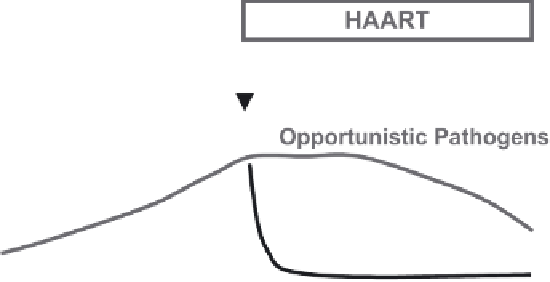Biology Reference
In-Depth Information
Figure 20.6. Memory CD4 T cell re-expansion with HAART requires re-exposure to antigens.
The rapid viral load reduction allows an early reappearance of CD4 cell responses to opportunistic
antigens that contrasts with the lack of restoration of CD4 T-cell responses to HIV antigens. This
phenomenon can be explained by the distinct exposure of these various T cells to their respective
pathogens. HAART directly reduces production of HIV antigens but does not directly a¨ect pro-
duction of opportunistic pathogens that are present in quantities su½cient to allow re-expansion of
memory T cells.
might be explained by the di¨erences in the exposure to appropriate antigenic
stimuli ( Fig. 20.6). Signi®cant virus production seems to be required for ap-
propriate stimulation, proliferation, and re-expansion of antigen-speci®c CD4
T cells. Because the amounts of CMV or Candida antigens are not immediately
a¨ected by HAART, the resurging memory CD4 T cells speci®c for those
pathogens are rapidly restimulated and can re-expand. In contrast, production
of HIV antigens rapidly disappears with HAART and the speci®c CD4 cells
cannot be appropriately restimulated or expanded ( Fig. 20.6). Similarly, a de-
cline of HIV-speci®c CD8 T cells ( Dalod et al., 1998; Gray et al., 1999; Kalams
99; Mollet et al., 2000; Ogg et al., 1999) and antibody titers (Morris et al., 1998)
was reported to parallel virus reduction. The hypothesis of a bolus of HIV
antigen too low to allow memory T-cell expansion might contrast with the
®ndings of a persisting reservoir of virus in tissues (Chun et al., 1997; Finzi
et al., 1997; Zhang et al., 1999b). This reservoir is, however, replicating at a rate
too low to stimulate appropriately T cells. The treated patients are thus left
with a strong and protective immunity against any pathogen except HIV itself.
Such partial immune reconstitution might also re¯ect some defect in the
ability of the antigen-presenting cell network to e½ciently prime new naive
CD4 and CD8 T cells. We demonstrated, indeed, that a defect in the frequen-
cies of peripheral blood dendritic cells expressing the CD11c molecule and
producing IL-12, which was not restored during treatment (Grassi et al., 1999).
Memory against HIV persists, however, even at very low levels, and is re-
inducible. Peaks of HIV-speci®c CD4 cell numbers have been registered during
short periods of virus replication when treatment fails or is interrupted (Carce-
















